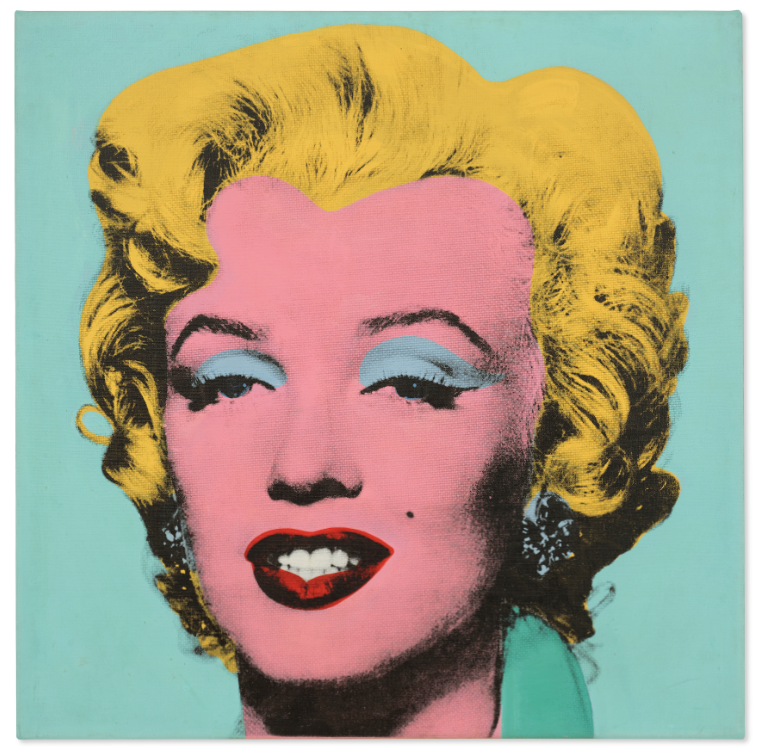Marilyn Monroe Pop Art With Pills by Her Head

Shot Sage Blue Marilyn
acrylic and silkscreen ink on linen
40 x twoscore in. / 101.6 10 101.6 cm.
Painted in 1964.
"IF you call back the '60s, yous weren't really there." This famous quip says much virtually our rose-tinted nostalgia for the decade. The fun-loving hedonism of Woodstock and Beatlemania may be etched into cultural retentivity, merely Andy Warhol's Marilyn Monroe portraits reveal a darker side to the swinging '60s that turns our nostalgia on its caput.
Warhol's iconic Marilyn Monroe portrait Shot Sage Blueish Marilyn, due to go on sale at Christie's in May, is expected to fetch tape-breaking bids of $200 million (£153 billion), making information technology the most expensive 20thursday century artwork ever auctioned. Near threescore years afterward they were first created, Warhol's portraits of the ill-fated Hollywood star continue to fascinate the states.
According to Alex Rotter, Christie's chairman for 20th and 21st century art, Warhol's Marilyn is "the accented pinnacle of American Pop and the promise of the American dream, encapsulating optimism, fragility, glory and iconography all at once."
Hollywood stars were great sources of inspiration for the Pop art motility. Monroe was a recurring motif, not only in the work of Warhol just in the work of his contemporaries, including James Rosenquist'southward Marilyn Monroe, I and Pauline Boty'south Colour Her Gone and The Only Blonde in the Earth.
Born Norma Jeane Mortenson but renamed Marilyn Monroe by 20th Century Trick, the actress went on to become one of the nigh illustrious stars of Hollywood history, famed for her roles in classic films like Gentlemen Prefer Blondes and Some Like It Hot. She epitomized the glitzy world of consumerism and celebrity that Pop artists thought was allegorical of 1950s and 1960s American culture.
While Rotter's statement may be true to some extent, there is also a sinister edge to the Marilyns because many were produced in the months post-obit her unexpected death in 1962.
On the surface, the works may wait like a tribute to a much-loved icon, just themes of death, disuse, and even violence lurk within these canvases. Clues can often be constitute in the product techniques. One of the drove'south most famous pieces, Marilyn Diptych, uses flaws from the silkscreen process to create the effect of a decaying portrait. Warhol's The Shot Marilyns consists of iv canvases shot through the brow with a unmarried bullet. In this, the creation of Warhol'south art is as important equally the artwork itself.
At a glance, the surface-level glamor of Warhol'due south Marilyn immortalizes the actress as a blonde bombshell of Hollywood'south bygone era. It is easy to forget the tragedy behind the paradigm, yet part of our enduring fascination with Marilyn Monroe is her tragedy.
Her mental health struggles, her tempestuous personal life, and the mystery surrounding her death have been well documented in countless biographies, films, and television set shows, including Netflix's documentary The Mystery of Marilyn Monroe: The Unheard Tapes and upcoming biopic Blonde. She epitomizes the familiar narrative of the tragic icon that is doomed to keep repeating itself — something that Warhol understood all also well after surviving a shooting past Valerie Solanas in 1968.
The death at the heart of Warhol'southward Marilyns is non just rooted in grief simply is also a reflection of the wider cultural landscape. The 1960s were a remarkably dark catamenia in 20thursday century American history. A cursory wait at the context in which Warhol was producing these images reveals a decade plagued past a series of traumatic events.
Life Magazine published violent photographs of the Vietnam War. Tv set broadcasts exposed shocking police brutality during civil rights marches. America was shaken by the assassinations of John F Kennedy, Robert Kennedy, and Martin Luther King, Jr. Footage of JFK's death captured past bystander Abraham Zapruder was repeatedly broadcast on boob tube. Celebrated Hollywood stars were dying immature and in tragic circumstances, from Marilyn Monroe and Judy Garland to Jayne Mansfield and Sharon Tate.
This image of the 1960s is echoed by the postmodern theorist Fredric Jameson, who describes the decade as a "virtual nightmare" and a "historical and countercultural bad trip." Stars like Monroe were not as flawless as they may announced in Warhol's portraits, simply were "notorious cases of burnout and self-destruction."
Warhol understood this more than anyone. His Death and Disaster serial explores the spectacle of death in America and affirms the 1960s as a fourth dimension of feet, terror, and crisis. The series consists of a vast collection of silkscreened photographs of real-life disasters including machine crashes, suicides, and executions taken from newspapers and constabulary archives. Famous deaths are also a central theme of the series, including portraits of Marilyn Monroe, Elizabeth Taylor, and Jackie Kennedy — all of whom are associated with pregnant deaths or nearly-expiry experiences.
Death and Disaster came about in 1962 when Warhol's collaborator Henry Geldzahler suggested that the artist should end producing "affidavit of life" and instead explore the dark side of American culture:
Maybe everything isn't always so fabulous in America. It'southward time for some death. This is what's really happening.
He handed Warhol a re-create of the New York Daily News, which led to the first disaster painting 129 Die in Jet!.
The recent hype effectually the auctioning of the Marilyn portrait reveals every bit much about our time as information technology does about our nostalgia for the 1960s. We choose to remember the decade in all its glorious technicolor, only uncovering its darker moments provides room for reconsideration. Perchance Warhol's Marilyn is non simply a symbol of the swinging '60s, but an artefact from a fourth dimension that was as turbulent and uncertain as our ain.
Harriet Fletcher is an Associate Lecturer in English language and History at the Lancaster Academy.
Source: https://www.bworldonline.com/arts-and-leisure/2022/04/20/443022/andy-warhols-marilyn-monroe-portraits-expose-the-darker-side-of-the-60s/
0 Response to "Marilyn Monroe Pop Art With Pills by Her Head"
Post a Comment